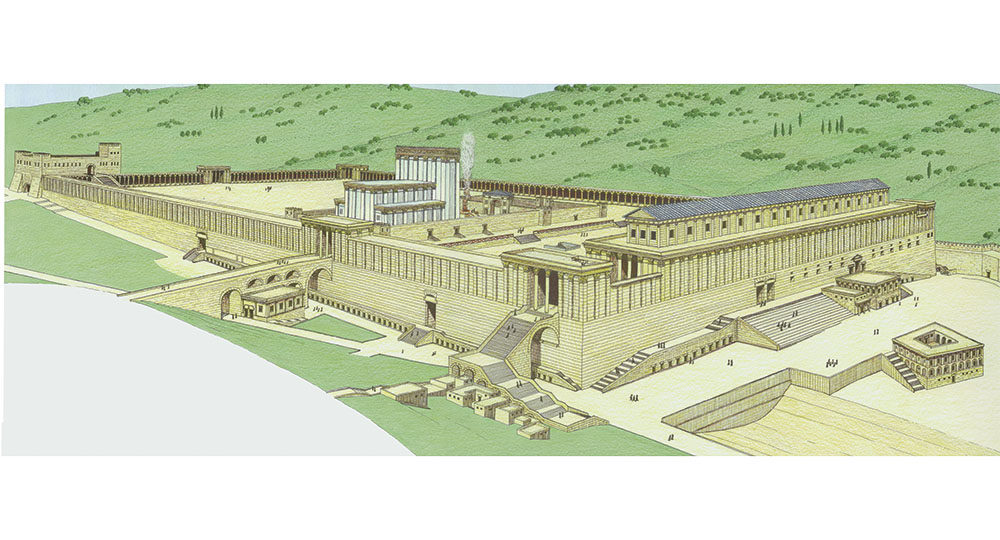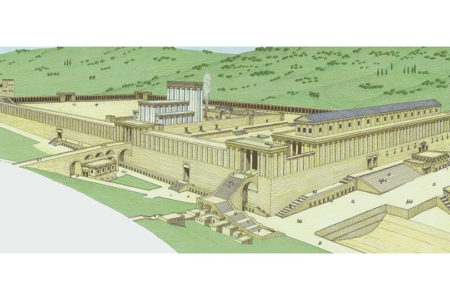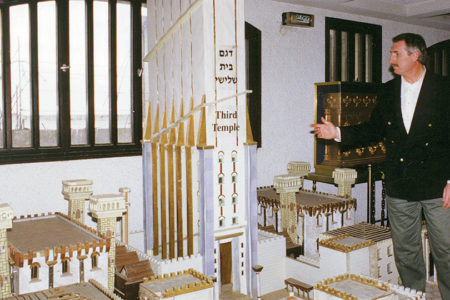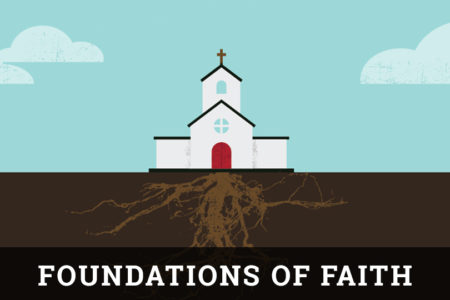The Temple in the First Century
“He who has not seen Herod’s Temple has never seen a beautiful building.” With those deliberately exaggerated words, rabbis extolled the magnificence of the Temple that was in Jerusalem during the first century A.D. Although the religious Jews often despised the nonreligious Herod, even they recognized the ornament of beauty he had constructed for the worship of their covenant God, Yahweh. In addition to the references in the New Testament, we are indebted to the Jewish historian, Josephus, for providing a detailed description of the Temple and its environs before it came to its untimely end in 70 A.D. With further insight gained from the archaeologists’ work over the last 30 years, we are now better able than ever before to visualize what this mighty edifice must have looked like to the generations of worshipers who thronged its elaborate courts.
The Construction of the Temple
The Temple of the first century was actually the last in a series of temples on Mount Moriah whose history had spanned a thousand years. The Tabernacle served Israel’s worship needs for more than 400 years—from Moses to David. Solomon, however, was the first to construct a Temple (something like a permanent Tabernacle). This grand sanctuary, described in 1 Kings 7–9, lasted until its destruction by the Babylonians in 586 B.C. When a remnant of Jews returned under the leadership of Zerubbabel, the next Temple was completed in 516 B.C., exactly 70 years after its destruction. Enemies never destroyed that Zerubbabel Temple, although the Syrians did defile it for a period of three years (168–165 B.C.). Herod began his new construction around 20 B.C. Some confusion arises at this point, since both Zerubbabel’s and Herod’s Temples are referred to collectively as the Second Temple. This is because Herod’s work was actually a reconstruction rather than an entirely new venture. His new Temple, however, was such an enlargement and embellishment of the Zerubbabel structure that it was practically a brand new building.
Herod envisioned a greatly enlarged Temple area with an enormous courtyard. This was a very difficult goal to achieve, since the Temple sat atop the pinnacle of Mount Moriah. To accommodate his plans, his engineers built huge retaining walls more than 150 feet high from bedrock west of the Temple and on the slopes up from the Kidron Valley to the east. With thousands of tons of backfill material, his workmen flattened the top of the mount. The lower stone courses of those walls can be seen today on the three sides of the present Temple Mount and have been further exposed by archaeologists. The dimensions exceed 1,500 feet long (north to south) and 900 feet wide—an area of more than 40 acres. Herod’s gigantic building stones, called ashlars, were cut from a nearby quarry and finished with a special flat facing and embossed edging. Herod’s many building projects all over Israel can thus be discerned by modern visitors, but none was as elaborate as his masterpiece, the Temple.
Enough construction was done so that the central part of the sacrificial area was finished in seven years. Herod trained thousands of priests as stonemasons and laborers so that they alone could work in the most sacred and restricted areas. The remainder of this enormous building project, with its numerous courts and chambers, continued throughout the period of Jesus’ life and ministry (note the reference in Jn. 2:20). The finishing touches were not actually completed until around 64 A.D., just six years before it was destroyed.
A Tour of the Temple
The Herodian Temple consisted of two basic areas: a central sanctuary and an outer courtyard. (At this point, the reader should carefully consult the accompanying excellent diagram, based on the most recent archaeological and architectural research.) The sanctuary could be called the Temple Proper, since it was there that the main sacrificial activities took place. Entering the sanctuary from the east through the Beautiful Gate—where Peter and John encountered the lame man (Acts 3:1–2)—any Jewish person, male or female, could enter the Court of the Women. Although such a court was never mentioned in the Old Testament, women in the first century could not proceed past this precinct. A number of Gospel incidents took place there, such as the account of the widow’s mites in Luke 21:1–4. We recognize how appropriate this reference is when we realize that the Court of the Women contained large, fluted receptacles for the worshipers’ offerings. Furthermore, Jesus probably witnessed a Pharisee and a tax collector praying in this area, giving rise to His parable in Luke 18:9–14.
Proceeding through the courtyard, people would climb the 15 steps of a large staircase, where the Levites would sing the Psalms in the daily liturgy. At the top of the stairs, Israelite males proceeded through the ornate Nicanor’s Gate into the Court of Israel. This small section, limited to men, was where the worshipers would hand their sacrifices over a small fence to priests on the other side in the appropriately named Court of the Priests. In this area, blocked from public view by high walls, the animals were slaughtered and their carcasses placed on the huge bronze altar. An elaborate system of drainage channels helped solve the problems associated with such a large number of bleeding animals. Although the sources make no mention of the laver, it certainly was there as well, since it is mentioned as part of the earlier Tabernacle. In fact, there were 12 lavers in the Solomonic Temple, supported on the backs of twelve brazen oxen.
With a wooden infrastructure, the Temple sanctuary was covered with polished limestone and adorned with gold and silver. As the sun rose over the Mount of Olives, the Temple would explode in a brilliance that could nowhere be approached.
Surrounding the sanctuary and these courtyards was a low fence that separated the Israelite worshipers from the Gentile visitors. Hence, the vast courtyard area was called the Court of the Gentiles. Attached to this fence, or balustrade, were a number of plaques warning Gentiles that they would be responsible for their own deaths if they proceeded beyond it. Paul was almost torn apart by the crowd for supposedly taking a Gentile past this barricade (Acts 21:18–29). Many think that this is the background of Paul’s discussion of “the middle wall of partition” that was destroyed by Christ, who made believing Jews and Gentiles one in Himself (Eph. 2:14). This vast Court of the Gentiles was where the moneychangers and sellers of animals had their tables and stalls, and it was this Temple court that Jesus cleansed (Mt. 21:12–13).
On the inner sides of this esplanade were ornate, covered porticoes where people could find protection from the weather as they gathered to hear teachers of the word. One of these—Solomon’s Portico—is mentioned as such a site for Jesus’ ministry (Jn. 10:23) and also for the early Jewish believers (Acts 3:11; 5:12). Outside the huge retaining walls were other important features on both the northern and southern sides. At the northwest corner of the Temple Mount was the huge Antonia Fortress, where Roman soldiers kept a watchful eye on the Jewish crowds (note Acts 21:34 ff). Although in a minority now, some scholars believe that the ancient flagstones presently seen in this area comprise the stone pavement on which Jesus was condemned by Pilate (Jn. 19:13). On the southern flank of the Temple, a huge staircase has been uncovered that led up to the Huldah Gates, which opened into underground passages to the surface. Here Jesus could have delivered many of His sermons, since the steps were popular with other rabbis as well. Dozens of ritual immersion pools, called mikvaot—which both men and women would visit before ascending in a holy state to the Temple enclosure—can now be seen. In light of these discoveries, the visit of the young couple with a little baby recorded in Luke 2:22–38 takes on new and exciting significance.
For years the pinnacle of the Temple, mentioned in Matthew 4:5, was pointed out at the southeast corner of the walls. Discovery of a broken inscription mentioning the “place of the trumpeting” at the southwest foot of the walls now causes many scholars to see this point as the most probable site for the temptation (see diagram). Finally, below this southwestern corner and jutting out of the wall was a palatial staircase that made a left turn downward into the street level below. Only the spring of the arch jutting out from the wall remains. It is known as Robinson’s Arch, after the 19th-century explorer who identified it.
While there are many additional features of the Temple area that could be mentioned, these few places indicate what a magnificent structure it was. Herod may not have been very “great” in his personal character, but as a builder, there was none his equal in the ancient world.
The Destruction of the Temple
In 66 A.D., the Jewish people of the Roman province of Judea rebelled against their Roman overlords. Four years later, after the destruction of a number of Jewish fortresses in the Galilee, the Roman army headed by Titus, son of the new Emperor Vespasian, stood before the walls of Jerusalem and began to lay siege to the enlarged Passover population inside. Within the walls, quarreling Jewish factions, accompanied by the ravages of plague and famine, added to the misery of its once proud citizens. As the siege wore on, the Romans slowly but steadily penetrated the Jewish defenses in the northern sections of the city until they were ready to scale the huge walls of the Holy Temple itself. The Temple, due to its location and structure, had actually become a fortress, even though the priests continued the daily services almost to the bitter end. That day arrived on the Ninth of Av (in August)—a date that to Jewish people will always “live in infamy.”
The Roman soldiers finally broke through and began to massacre priests, Jewish soldiers, and anyone else who stood in their way. Josephus stated that General Titus wanted to spare the Temple. Nevertheless, a soldier threw a torch that ignited the curtains of the Inner Temple courts. In a matter of hours, the ensuing conflagration engulfed and destroyed everything flammable in the Temple and its courtyards. Enraged and frustrated Roman wrecking crews systematically finished the devastation and pillage in the days that followed. The huge multi-ton limestone ashlars lying at the base of the Temple retaining wall bear mute witness to the enormity of the tragedy. Josephus stated that the destruction was so great that a subsequent visitor to the mount would not have known that a Temple had been there before. The elaborate ritual of sacrifice, inaugurated 1,400 years before at Mount Sinai, came to a crashing end—a state of affairs that has continued to the present day.
Should all of this have been a surprise? Just a few years before, the Jewish believers had left the city, aware of its inevitable destruction. After a sojourn of safety in Pella beyond the Jordan, they returned to continue their faithful witness that had been carried on so effectively under the leadership of James, the Lord’s brother, until his murder in 62 A.D. Perhaps these believers also were aware that one of their Messiah’s prophecies had made the Temple’s doom certain.
And Jesus went out, and departed from the temple; and his disciples came to him to show him the buildings of the temple.
And Jesus said unto them, See ye not all these things?
Verily I say unto you, There shall not be left here one stone upon another, that shall not be thrown down (Mt. 24:1–2).
What more did they need?







1 thought on “The Temple in the First Century”